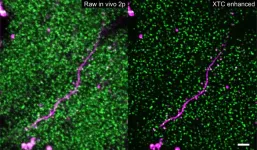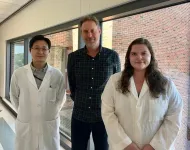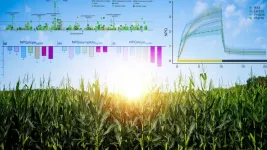(Press-News.org) FOR IMMEDIATE RELEASE
Johns Hopkins scientists have developed a method involving artificial intelligence to visualize and track changes in the strength of synapses — the connection points through which nerve cells in the brain communicate — in live animals. The technique, described in Nature Methods, should lead, the scientists say, to a better understanding of how such connections in human brains change with learning, aging, injury and disease.
“If you want to learn more about how an orchestra plays, you have to watch individual players over time, and this new method does that for synapses in the brains of living animals,” says Dwight Bergles, Ph.D., the Diana Sylvestre and Charles Homcy Professor in the Solomon H. Snyder Department of Neuroscience at the Johns Hopkins University (JHU) School of Medicine.
Bergles co-authored the study with colleagues Adam Charles, Ph.D., M.E., and Jeremias Sulam, Ph.D., both assistant professors in the biomedical engineering department, and Richard Huganir, Ph.D., Bloomberg Distinguished Professor at JHU and Director of the Solomon H. Snyder Department of Neuroscience. All four researchers are members of Johns Hopkins’ Kavli Neuroscience Discovery Institute.
Nerve cells transfer information from one cell to another by exchanging chemical messages at synapses (“junctions”). In the brain, the authors explain, different life experiences, such as exposure to new environments and learning skills, are thought to induce changes at synapses, strengthening or weakening these connections to allow learning and memory. Understanding how these minute changes occur across the trillions of synapses in our brains is a daunting challenge, but it is central to uncovering how the brain works when healthy and how it is altered by disease.
To determine which synapses change during a particular life event, scientists have long sought better ways to visualize the shifting chemistry of synaptic messaging, necessitated by the high density of synapses in the brain and their small size — traits that make them extremely hard to visualize even with new state-of-the-art microscopes.
“We needed to go from challenging, blurry, noisy imaging data to extract the signal portions we need to see,” Charles says.
To do so, Bergles, Sulam, Charles, Huganir and their colleagues turned to machine learning, a computational framework that allows flexible development of automatic data processing tools. Machine learning has been successfully applied to many domains across biomedical imaging, and in this case, the scientists leveraged the approach to enhance the quality of images composed of thousands of synapses. Although it can be a powerful tool for automated detection, greatly surpassing human speeds, the system must first be “trained,” teaching the algorithm what high quality images of synapses should look like.
In these experiments, the researchers worked with genetically altered mice in which glutamate receptors — the chemical sensors at synapses — glowed green (fluoresced) when exposed to light. Because each receptor emits the same amount of light, the amount of fluorescence generated by a synapse in these mice is an indication of the number of synapses, and therefore its strength.
As expected, imaging in the intact brain produced low quality pictures in which individual clusters of glutamate receptors at synapses were difficult to see clearly, let alone to be individually detected and tracked over time. To convert these into higher quality images, the scientists trained a machine learning algorithm with images taken of brain slices (ex vivo) derived from the same type of genetically altered mice. Because these images weren’t from living animals, it was possible to produce much higher quality images using a different microscopy technique, as well as low quality images — similar to those taken in live animals — of the same views.
This cross-modality data collection framework enabled the team to develop an enhancement algorithm that can produce higher resolution images from low quality ones, similar to the images collected from living mice. In this way, data collected from the intact brain can be significantly enhanced and able to detect and track individual synapses (in the thousands) during multiday experiments.
To follow changes in receptors over time in living mice, the researchers then used microscopy to take repeated images of the same synapses in mice over several weeks. After capturing baseline images, the team placed the animals in a chamber with new sights, smells and tactile stimulation for a single five-minute period. They then imaged the same area of the brain every other day to see if and how the new stimuli had affected the number of glutamate receptors at synapses.
Although the focus of the work was on developing a set of methods to analyze synapse level changes in many different contexts, the researchers found that this simple change in environment caused a spectrum of alterations in fluorescence across synapses in the cerebral cortex, indicating connections where the strength increased and others where it decreased, with a bias toward strengthening in animals exposed to the novel environment.
The studies were enabled through close collaboration among scientists with distinct expertise, ranging from molecular biology to artificial intelligence, who don’t normally work closely together. But such collaboration, is encouraged at the cross disciplinary Kavli Neuroscience Discovery Institute, Bergles says. The researchers are now using this machine learning approach to study synaptic changes in animal models of Alzheimer’s disease, and they believe the method could shed new light on synaptic changes that occur in other disease and injury contexts.
“We are really excited to see how and where the rest of the scientific community will take this,” Sulam says.
The experiments in this study were conducted by Yu Kang Xu (a Ph.D. student and Kavli Neuroscience Discovery Institute fellow at JHU), Austin Graves, Ph.D. (assistant research professor in biomedical engineering at JHU) and Gabrielle Coste (neuroscience Ph.D. student at JHU). This research was funded by the National Institutes of Health (RO1 RF1MH121539).
END
Scientists use machine learning to ‘see’ how the brain adapts to different environments
Visualizing connections between nerve cells in brains of mice is enabled by artificial intelligence
2023-06-05
ELSE PRESS RELEASES FROM THIS DATE:
Cancer discoveries could enhance immunotherapy, breast cancer care
2023-06-05
Two new discoveries from the Dudley lab at UVA Cancer Center highlight the different roles of blood vessels in solid tumors – and the findings could help prevent breast cancer from spreading and enhance the effectiveness of one of the most important new cancer treatments in many years.
In one new scientific paper, researcher Andrew C. Dudley, PhD, and his team report that the effectiveness of immunotherapy drugs called immune check blockade is enhanced when blood vessels are targeted in a specific way. (Immunotherapy enhances the power of the immune system to fight cancer and other diseases.) In another paper, published ...
Refining surge protector in crops could boost yields
2023-06-05
Awash in a rowed sea of its brethren, a corn leaf relegated to the lowest rung of its stem spends much of a June afternoon doused in shade cast by the higher-ups.
Then a gust begins pushing, pulling and twisting the waxy wings in concert, cracking a window to the fireball roiling 93 million miles away. It’s a prime, precious opportunity for photosynthesis to transform the sunlight into food. Unfortunately, the photosynthetic equivalent of a surge protector — one evolved to help plants mitigate damage driven by sudden spikes of high-intensity light — is slow to reset after so much time in the shade. The gust dissipates, the moment ...
Moving towards a more inclusive approach to medicine
2023-06-05
Moving towards a more inclusive approach to medicine
Release of pangenome representing wide diversity of individuals ushers in new understanding of human biology and disease
The first human genome, which has served as the reference until now, was released approximately 20 years ago. It was a landmark accomplishment that had a huge impact on biomedical research and changed the way scientists study human biology. But it was based on just a few individuals and did not capture the full genetic diversity of the human population.
An important step forward for both biology and biomedical research
“Since ...
SwRI investigates accuracy of flow meters measuring hydrogen and natural gas blends
2023-06-05
SAN ANTONIO — June 5, 2023 —Southwest Research Institute is expanding its flow meter research in collaboration with NYSEARCH, a nonprofit research and development organization for the gas industry, to address the impact of introducing hydrogen and natural gas blends into the residential and commercial energy mix. In the second phase of the program, SwRI will expand its research in measuring the energy content of blended gas to determine the accuracy of current flow meter technology for monitoring usage in homes.
Natural gas is widely used to power appliances and heat ...
Social media posts can be used to track individuals’ income and economic inequalities
2023-06-05
Researchers from Queen Mary University of London analysed 2.6 million posts on popular social media network Nextdoor and accurately predicted individuals’ income by solely examining the posts they’ve published. Striking differences in the content shared by people who live in wealthier versus poorer neighbourhoods has led researchers to believe that our general online posting activity, beyond Nextdoor, can reveal our socioeconomic status, making user profiling possible.
Knowing users’ income could allow social media platforms to recommend income-based content, and advertisers and online shops can target people based on their ...
ASCO: Targeted therapy achieves responses across multiple cancer types with FGFR alterations
2023-06-05
ABSTRACTS: 3121, 4504, LBA4619
CHICAGO ― Three clinical trials led by researchers at The University of Texas MD Anderson Cancer Center demonstrated positive results from the targeted therapy erdafitinib for patients with multiple tumor types harboring FGFR alterations. The data are being presented at the 2023 American Society of Clinical Oncology (ASCO) Annual Meeting.
Erdafitinib is an oral medication that blocks the activity of FGFR signaling proteins, which are important for a variety of normal cellular processes. However, FGFR genetic alterations can drive the development of many ...
Patchwork of mutations contributing to bipolar disorder
2023-06-05
Bipolar disorder (BD) is a major psychiatric condition that afflicts about 1% of people. Symptoms of BD include sudden onset of depressive mood with loss of interest which alternates with a manic state of hyperactivity. The suffering of the patients and societal cost of this disorder requires the use of continued therapeutic management. Current medications—although vital for patients with BD—are not perfect solutions, given their potential side-effects and treatment resistance. This necessitates ...
Zap Energy charts roadmap for measuring fusion gain
2023-06-05
In the race to develop fusion energy, each unique approach requires its own specialized techniques to determine net energy gain, an equation balancing energy in and out that’s known by the letter Q.
A new paper, published today in the journal Fusion Science and Technology, establishes the company’s method of measuring and calculating Q in Zap’s sheared-flow-stabilized Z-pinch fusion plasmas. The publication will be an important part of Zap demonstrating energy gain on the way to building a commercial fusion ...
Children with attention, behavior problems earn less money, have less education, poorer health as adults
2023-06-05
Children who struggle with attention and behavior problems tend to end up earning less money, finish fewer years of school and have poorer mental and physical health as adults, compared with children who don’t show early attention and behavior problems, according to research published by the American Psychological Association.
Children who struggle with attention are particularly likely to have lower levels of educational attainment as adults, while those who struggle with impulsivity are more likely to end up in trouble with the law, the research found.
“Our study found broad support ...
Previously unknown antibiotic resistance widespread among bacteria
2023-06-05
Genes that make bacteria resistant to antibiotics are much more widespread in our environment than was previously realised. A new study, from Chalmers University of Technology and the University of Gothenburg in Sweden, shows that bacteria in almost all environments carry resistance genes, with a risk of them spreading and aggravating the problem of bacterial infections that are untreatable with antibiotics.
“We have identified new resistance genes in places where they have remained undetected until now. These genes can constitute an overlooked threat to human health,” says Erik Kristiansson, a professor in the Department ...
LAST 30 PRESS RELEASES:
B cells transiently unlock their plasticity, risking lymphoma development
Advanced AI dodel predicts spoken language outcomes in deaf children after cochlear implants
Multimodal imaging-based cerebral blood flow prediction model development in simulated microgravity
Accelerated streaming subgraph matching framework is faster, more robust, and scalable
Gestational diabetes rose every year in the US since 2016
OHSU researchers find breast cancer drug boosts leukemia treatment
Fear and medical misinformation regarding risk of progression or recurrence among patients with breast cancer
Glucagonlike peptide-1 receptor agonists and asthma risk in adolescents with obesity
Reviving dormant immunity: Millimeter waves reprogram the immunosuppressive microenvironment to potentiate immunotherapy without obvious side effects
Safety decision-making for autonomous vehicles integrating passenger physiological states by fNIRS
Fires could emit more air pollution than previously estimated
A new way to map how cells choose their fate
Numbers in our sights affect how we perceive space
SIMJ announces global collaborative book project in commemoration of its 75th anniversary
Air pollution exposure and birth weight
Obstructive sleep apnea risk and mental health conditions among older adults
How talking slows eye movements behind the wheel
The Ceramic Society of Japan’s Oxoate Ceramics Research Association launches new international book project
Heart-brain connection: international study reveals the role of the vagus nerve in keeping the heart young
Researchers identify Rb1 as a predictive biomarker for a new therapeutic strategy in some breast cancers
Survey reveals ethical gaps slowing AI adoption in pediatric surgery
Stimulant ADHD medications work differently than thought
AI overestimates how smart people are, according to HSE economists
HSE researchers create genome-wide map of quadruplexes
Scientists boost cell "powerhouses" to burn more calories
Automatic label checking: The missing step in making reliable medical AI
Low daily alcohol intake linked to 50% heightened mouth cancer risk in India
American Meteorological Society announces Rick Spinrad as 2026 President-Elect
Biomass-based carbon capture spotlighted in newly released global climate webinar recording
Illuminating invisible nano pollutants: advanced bioimaging tracks the full journey of emerging nanoscale contaminants in living systems
[Press-News.org] Scientists use machine learning to ‘see’ how the brain adapts to different environmentsVisualizing connections between nerve cells in brains of mice is enabled by artificial intelligence







